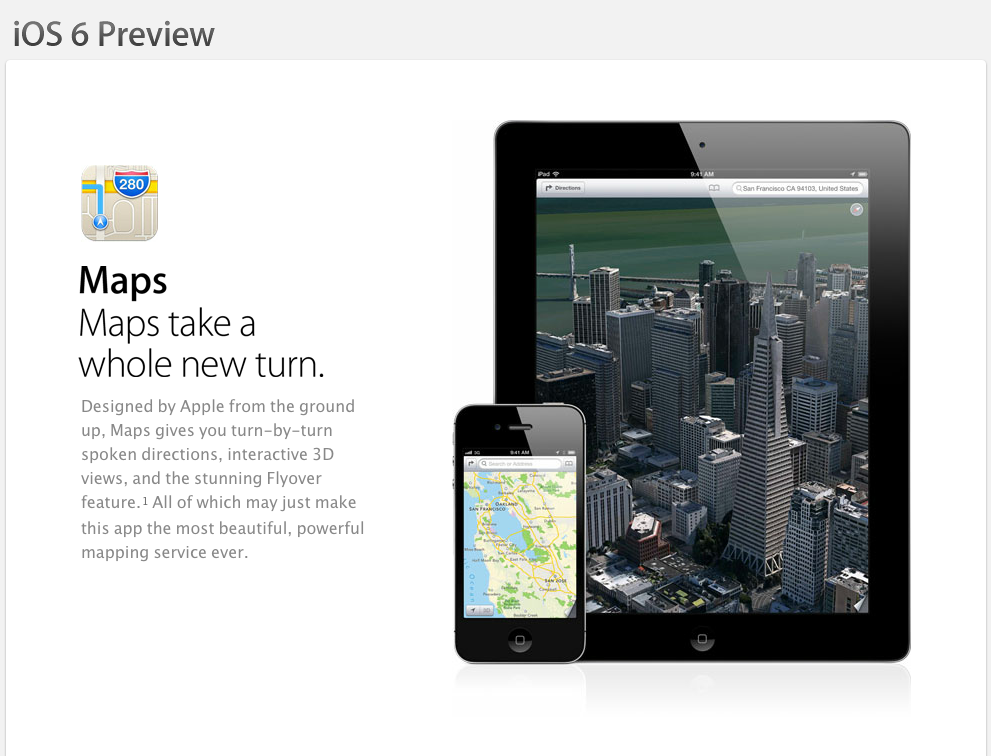Full Spectrum Competition: Apple Gets into Maps in a Big Way
As I have touched on before, Internet competition between “the big guys” is alive and well. In the latest example of this, we have the announcement that Apple is launching its own maps service as a part of iOS 6. Apple’s decision to abandon Google Maps comes in the wake of Foursquare abandoning Google Maps. These moves may be related to Google’s decision to start charging heavy users of its Google Maps API (of which Apple and Foursquare surely were). However, the decisions are likely much more fundamental.
Where mapping functionality, much like basic search, used to be a separate product, it is now a key component of more integrated and sophisticated suites of products and services. As location-specific information becomes more valuable, good mapping functionality becomes a crucial input to new apps and online tools. Apple and Foursquare want to provide their users a full-spectrum offering that is not reliant on one of their competitors for a core component of their product (especially when competitors can change pricing with little notice). This is true across the industry.
(As an aside, Foursquare and Apple are both using OpenStreetMap to power their mapping engines. OSM is a collaborative product with more than 600,000 registered users. We will address this frequently at DisCo, but incorporating “free” and “open source” products is an important way to disrupt incumbents on the Internet. Ironically, this is the very same model that Google used to challenge Apple’s mobile OS dominance.)
In this vein, it is not surprising that Facebook is rumored to be interested in purchasing Opera or that Google purchased Meebo to expand the functionality of Google+ because they do not want to be dependent on their rivals for core products or functionality. In creating its own maps product, Apple purchased several mapping companies including C3 Technologies, so it could enter the space more quickly.
This competition across a suite of services, besides being a smart business decision for these companies by helping them stay independent and relevant, means that there is pressure on Internet companies to innovate continuously. Just as Bing is forcing Google to constantly improve its search engine and Google+ is making Facebook compete on both functionality and privacy, Apple is putting more pressure on both Google and Microsoft with this latest announcement. As TPM makes clear, this competition is leading to better products:
Some in the burgeoning digital mapmaking industry believe that the fight between Google and Apple’s mapping software will actually be good for them.
“I think that it’s exciting for the industry,” said Terry Keating, the chief technology officer and senior VP at digital mapping and surveying company AeroMetric, in a phone interview with TPM. “It adds to the overall thirst for more and more details.”
Specifically, Keating said that his firm’s primary customer base — railroad and highway engineers, plant operators and other infrastructure project managers — would be prompted by the new detailed 3D maps of metropolitan areas offered by the likes of Google and Apple to request site-specific 3D renderings of pipelines and power or production plants, renderings that must be far more accurate than those provided by Apple and Google for the consumer market….
“The presentation modes that Apple has developed and released are generally forward-looking,” Keating said. “Apple has had an opportunity for years to see how Google has been presenting maps and how Microsoft has been presenting maps, and so now they are using what they’ve learned and trying to do better.”
What is Google left to do? As the Sydney Morning Herald argues, Google must continue–in earnest–to make better and cooler mapping services if they hope to entice iPhone users to continue using their product when it is no longer a default.
Google’s only option, now, is to keep investing more and more into its maps division in the hopes that, over time, customers will stick with it because it’s the better option. That has worked well for Google in the search business. But I wonder whether it will see the same returns in mapping. After all, even if Apple’s system doesn’t offer the same 3-D imagery that Google has, and if it can’t give you pictures of the inside of the Grand Canyon, will that really matter to most users? I suspect not.
Apple’s market share in the mobile space and its cash reserves make it an immediate and real threat to Google, even though it is a new player in the mapping space. And who knows, this may be more than fringe competition on Google’s left flank, but the beginning of more existential threat to its core business model.









